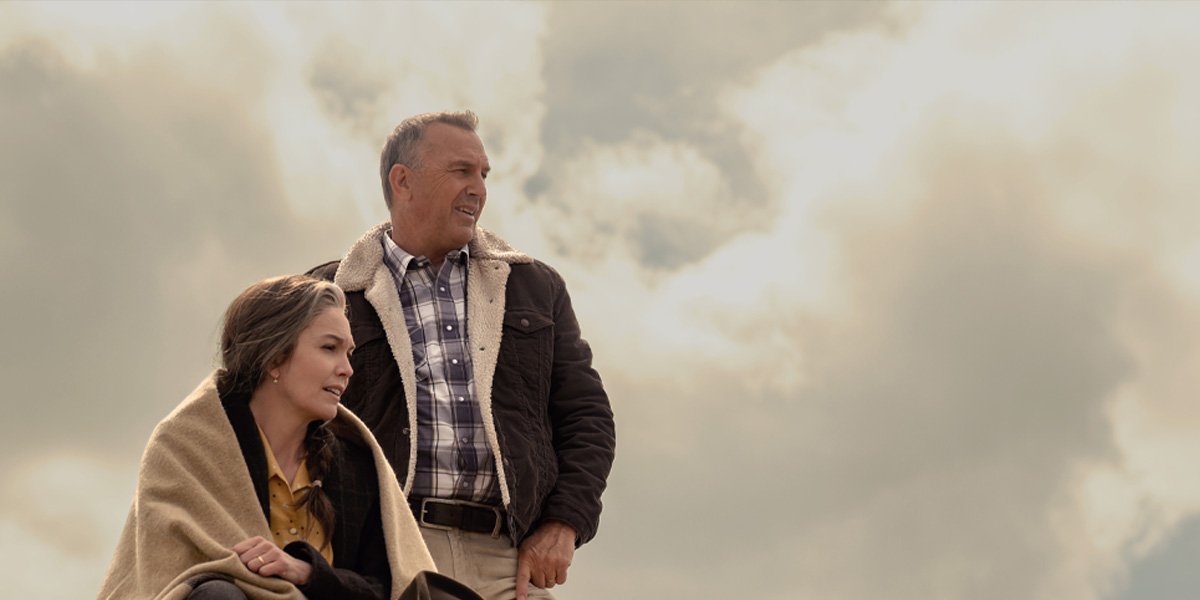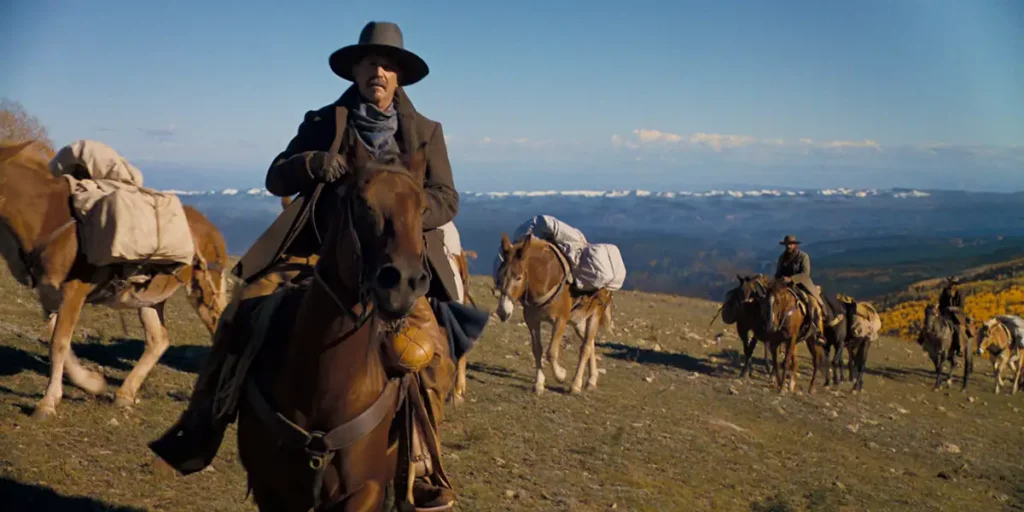While Chapter 1 of Horizon: An American Saga exudes an old-school Western magnetism, Costner’s vision and scope are televisual rather than cinematic.
Director: Kevin Costner
Genre: Western
Run Time: 181′
Global Release: June 28, 2024
Where to watch: in theaters
2024 has been the year of risky passion projects from veteran filmmakers and big-screen legends. Kevin Costner is one of them. The American actor and director has spent millions on the project he had longed to make since 1998: Horizon: An American Saga.
Much like Francis Ford Coppola with Megalopolis, Costner had been thinking about making an epic tale that covered the American West’s expansion through the effects of the Civil War for a long time. There were many conversations with studios and producers about making it, yet they all fell through, one by one. That is why he had to make many monetary sacrifices to create that project he couldn’t leave behind.
Instead of beinga single piece, Horizon: An American Saga is now a multi-film expedition into the West: four chapters portray the danger and diplomacy before, during, and after the American Civil War. This makes Costner’s canvas bigger than ever before. He now has total freedom to shape the story as he envisioned it long ago. This kind of liberty has caused many directors to get lost in their vision. However, there is some trust in Costner because he is no stranger to the Western genre in front and behind the camera.
And so, Chapter 1 of Horizon: An American Saga arrives in theaters with plenty of curiosity around it, whether it is a Heaven’s Gate or a Dances With Wolves scenario – a mess, or a surprising hit. For me, the film lands in between the two. While many outstanding sequences have that classic Western flair, Costner approaches the story like a series pilot episode that takes three hours to introduce its characters instead of moving the narrative along.
Horizon: An American Saga is set in Kansas, Wyoming, and Montana during the year 1859. The American Civil War is near, and you get that sensation of impending doom: the quietness in the plains makes the atmosphere feel cold while still kissed by the bright sun. Many narrative threads occur simultaneously in the film. Much like in the pilot episode of a television series, Costner introduces us to various characters that will eventually be under the same terrain at some point in the other chapters of Horizon: An American Saga. The event that sets off the chain reaction for these characters to connect is an Apache raid on a settler village named Horizon, a place deemed as prosperous by its inhabitants as it is considered unruly by outsiders, the ones who have been robbed of their land.

Horizon, situated on an Apache river crossing, is claimed by a group of Apaches led by Pionsenay (Owen Crow Shoe) as rightfully theirs. But First Lt. Trent Gephardt (Sam Worthington, of Avatar) says the opposite, which exalts a violent reaction from Pionsenay and his followers. The outcome causes great division and discourse among the locals. Some decide to take matters into their own hands, seeking revenge for the blood spilled on the place they call home. Meanwhile, those who can’t afford to make that sacrifice, like Frances Kittredge (Sienna Miller) and her daughter, stick with Gephardt and the Union Army in search of a safe place to inhabit.
When depicting the lives of the Native Americans, Kevin Costner does not delve into the exploitation of excessive violence. However, he commits some of the same mistakes that plagued his Best Picture-winning Dances with Wolves, making it less effective and humanistic. In Chapter 1, Costner does not capture the Native Americans’ history and past with enough seriousness and tactfulness.
Even though the most pivotal moment in the film involves them, the Native American characters are not developed properly. They are left to the side for most of the three-hour runtime, and all of their actions come with little to no backstory. It deprives them of their humanity, which ultimately causes the narrative to feel less genuine and gripping. At a time when you have films like Killers of the Flower Moon, where Martin Scorsese focused on trying to portray this culture and its rich history with plenty of diligence and respect, Chapter 1 of Horizon: An American Saga feels like a step in the wrong direction, and I hope this issue is fixed in the other installments.
The second plot strand takes place on the other side of the West. Nearly an hour into the film, we finally meet Kevin Costner’s Hayes Ellison. He is that trademark old cowboy who has left his rowdy life behind for a calmer one as a horse trader. Everything turns upside down, with a shift that will lead him to his previous life as a gunslinger upon the arrival of Marigold (Abbey Lee, of Lovecraft Country). Although her presence is like a bright light in these gray-colored plains, she brings on plenty of trouble. The slick Caleb Sykes (Jamie Campbell Bower, of Stranger Things) wants the kid Marigold is taking care of. Although he does not trust her from the get-go, Hayes protects her–developing the classic old-school versus new-school confrontation between the rugged, protective cowboy and the young troublemaker.
When you think those two storylines will run in unison until they intersect, a third one featuring Luke Wilson’s Matthew Van Weyden and a posh British couple is introduced. At first, you welcome all of these stories with open arms. There is plenty of interest in seeing where things are headed and how Costner’s before-and-after portrait of the Civil War will culminate. But when the credits arrive three hours later, you realize nothing has happened. What you received was all setup and zero narrative progress.
This occurs mainly because Kevin Coster spends too much of Chapter 1’s runtime to get audiences to see the following features rather than creating a project that can stand on its own legs. The film’s last few minutes confirm this. Costner gives you a teaser trailer of what is meant to happen in Chapter 2, much like a television show providing a glimpse into next week’s episode.
Let’s consider Peter Jackson’s Lord of the Rings trilogy. Jackson divided the classic book into The Fellowship of the Ring, The Two Towers, and Return of the King. He brilliantly arranged the different chapters of the book so that each film felt like an isolated expedition into Middle-earth. The Fellowship of the Ring introduced us to the lengthy, demanding journey that was to come, making us worry about the threat ahead while crafting a captivating film that one could watch without needing the other installments.
By the end, you got an excellent curtain closer that sparked intrigue for the following feature and, more importantly, felt like a complete narrative arc. In the case of Horizon: An American Saga – Chapter 1, the opposite happens. The three stories Costner presents have a beginning yet no middle or end. It makes the film immediately dependent on the others and can’t be enjoyed as a solo ride through the West.
Even though, narratively, the film does not function properly, it contains some alluring sequences and shots by cinematographer J. Michael Muro that capture the allure of the wild, wild west cherished by cinephiles worldwide. Costner makes sure that his movie has the scenery filled with that classical, throwback charm that immerses the viewer into this olden world. This comes via Costner’s expertise in the genre and knowledge of its cinematic history and impact, nodding to greats like John Ford, Howard Hawks, and Sergio Leone.
These references serve as small treats for us cinephiles, but this is most likely a “thank you” note for these legendary filmmakers. Costner has always been very vocal about his love for Westerns. He makes and wants to be a part of them because of his admiration for the genre. It is these films that have shaped his career; his most important contributions to cinema revolve around Westerns. So, he tips his hat to the ones that came before during his go-for-broke passion project.
There is a big chance that we will never see this lengthy project’s conclusion, as money dictates everything in Hollywood. Modern audiences are no longer seeking out Westerns of this magnitude or canvas. This is not the 1940s, 50s, or 60s when people rushed to the theater to see gunslingers, cowboys, riders, and rebels. But, somehow, Kevin Costner wants to rekindle the magic of the genre with the Horizon: An American Saga features. Unfortunately, he comes across a balancing act of medium contradictions; as the look and breadth feel cinematic, the storytelling and narrative structure are televisual, much like a season of the Costner-led Yellowstone or 1883.
I am interested in seeing where Kevin Costner is going with these narratives, as there are some intriguing segments and moments in Horizon: An American Saga – Chapter 1. But being forced to watch a story that seems to remain still for three hours is very frustrating.
Horizon: An American Saga Chapter 1 is out now globally in theaters.

 loudandclearreviews.com
loudandclearreviews.com
